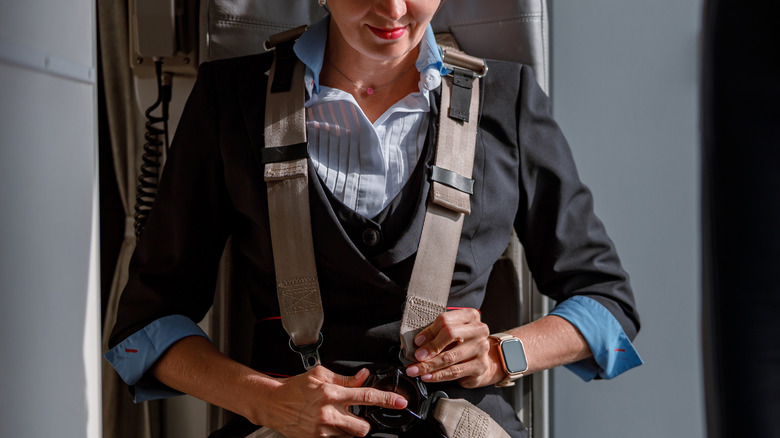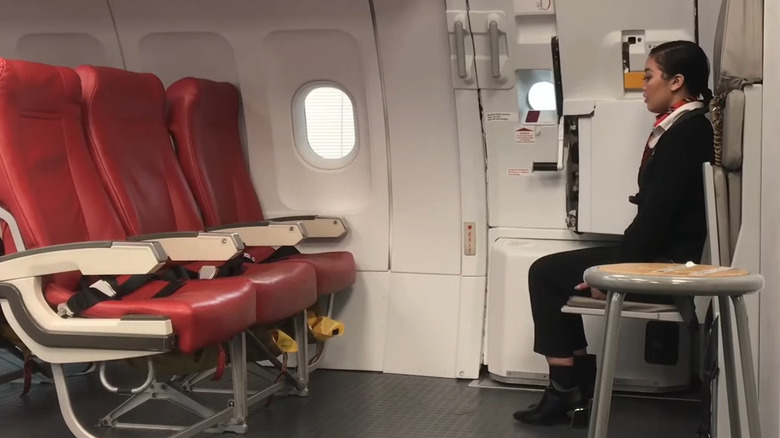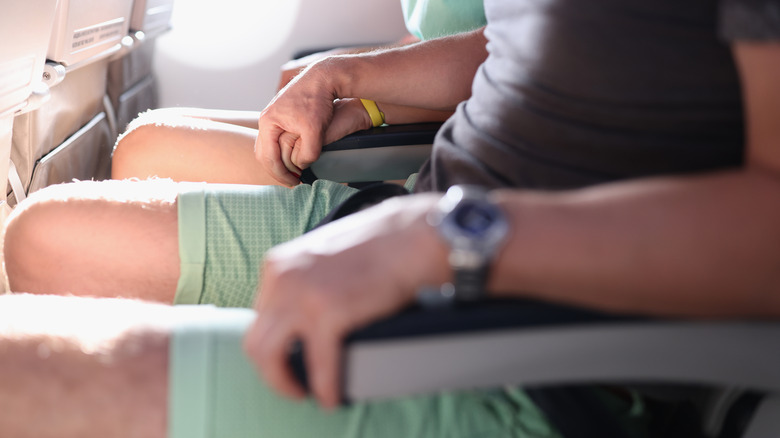The Unnerving Reason Flight Attendants Sit On Their Hands During Takeoff And Landing
If you've ever sat near the flight attendant jump seats, you might have noticed members of the cabin crew sitting on their hands while the plane takes off and lands. While planes are typically chilly, these flight attendants aren't just trying to keep their hands warm. Like many other things flight attendants have to do during your flight, it's all about safety. If there's turbulence or any kind of issue during takeoff and landing, this position can actually keep flight attendants safer.
To find out exactly why flight attendants are trained to do this, what other positions flight attendants may take during potentially bumpy parts of the flight, and whether or not passengers need to do the same, Islands spoke to 6-year flight attendant Court Acree, who is also a content creator who goes by Court Too Fly. Acree was able to shed a little light on this unusual position, explaining: "This helps them prepare for potential turbulence or emergencies and stay focused on keeping everyone safe. It's all about ensuring they're ready to assist passengers and avoiding unnecessary movement during these critical parts of the flight."
Brace positions are used by flight attendants for safety
Brace positions are positions that flight attendants are trained to do during situations where the flight may get bumpy. That could be as routine as turbulence during takeoff or as unusual and scary as an emergency landing. Not all brace positions require flight attendants to sit on their hands, however. According to Acree, exactly what position flight attendants are trained to do depends on where the airline is based, what kind of plane it is, and what sort of jump seats there are so that they can be as safe as possible.
"Different head positions, such as chin down, when facing toward the front of the aircraft and chin up when facing toward the back of the aircraft, protect the head and neck during sudden deceleration or turbulence, reducing the risk of injury," Acree explained. However, there are some common factors the vast majority of brace positions include. Acree told us that sitting upright, back against the back of the jump seat, with feet flat on the floor is completely standard.
Passengers typically don't need to sit on their hands
It seems like flights keep getting bumpier and bumpier. If flight attendants, some of the world's most frequent fliers, use brace positions like sitting on their hands in order to be safer during turbulence, it makes sense to wonder if you should do them too. However, according to Acree, that's not really necessary.
"Passengers do not need to sit on their hands," Acree told Islands. "Instead, they should focus on buckling their seatbelts low and tight across their hips and following safety instructions from the crew." Takeoff and landing are definitely the most critical parts of your flight, so while you don't need to sit on your hands, it's important that you stay in your seat — just like any other time the fasten seatbelt sign is on. Rather than assuming a brace position like a flight attendant, you're better off strapping in and soothing your plane anxiety with a pair of noise canceling headphones.


